[Das Seitenbannerfeature ist in diesem Web nicht verfügbar.]
[Das Navigationsleistenfeature ist in diesem Web nicht verfügbar.] [Das Navigationsleistenfeature ist in diesem Web nicht verfügbar.]
Photo series:
Here are some photos of that first banjo of mine that my
father brought home from the Outer Hebrides, where the good people had no idea
what it was and had no way of finding out, or of obtaining parts for it!
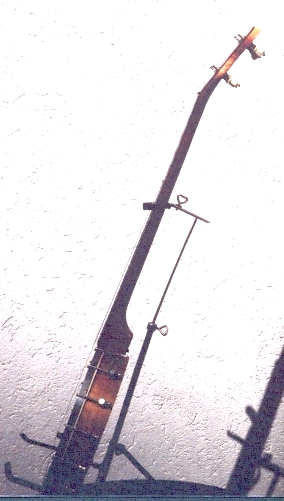 It
has no identifying markings of any kind, so it could
It
has no identifying markings of any kind, so it could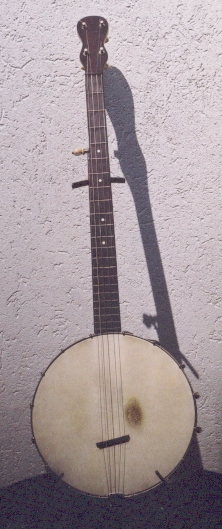 have come from anywhere. From an American sailor in need of ready cash,
perhaps? Or by mail order from a shop in the UK? Or brought home by some long
deceased islander from wherever he had been?
have come from anywhere. From an American sailor in need of ready cash,
perhaps? Or by mail order from a shop in the UK? Or brought home by some long
deceased islander from wherever he had been?
If you can deduce from some of the details where the
instrument came from, I would be delighted to hear from you!
At least I know that it is fairly old, because both it and
its case were already in a dilapidated condition back in the mid-1950s, when we
got it!
Front and side view
Simplicity is the keynote! There are only 16 tension hooks
(half as many as on some older banjos!) and only four fretboard markings (at the
5th, 7th, 10th and 12th frets), all of them simple MOP dots. There is no trace
of there ever having been an arm-rest. The outline of the peg-head is a very
clean figure-of-eight, or guitar shape. The tension hoop is plain, with no recesses for the hooks,
but the hooks are round and solid, though set in simple hexagonal shoes.
The fretboard and the peg-head overlay are rosewood
Back view
This shows the square-section dowel stick, which is clamped
to the rim with a cast-metal shoe and hardwood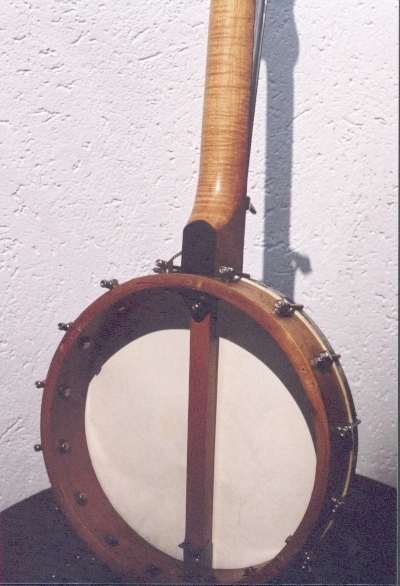 wedges. What you cannot see is the tone ring, which is a band of steel standing
a couple of millimetres proud of the wooden rim in a rebate in the outside of
the rim. The ends of the tone ring are not welded or soldered; the ring is held
snugly in place by the tension of the head. The flesh hoop (galvanised wire) is
also open.
wedges. What you cannot see is the tone ring, which is a band of steel standing
a couple of millimetres proud of the wooden rim in a rebate in the outside of
the rim. The ends of the tone ring are not welded or soldered; the ring is held
snugly in place by the tension of the head. The flesh hoop (galvanised wire) is
also open.
The neck is in nicely grained maple, the heel cap is of the
same rosewood as the fretboard, and the neck is still as straight as a die
Peg-head
The outline of the peg head is almost so simple as to be
characteristic. The pegs are the ones I installed in the early 1960s to replace
the incomplete set of originals. I replaced friction pegs with newer friction
pegs - in those days, friction pegs were what the music shop sold you if you
asked for banjo pegs! The originals were of a slightly different pattern, and
the knobs were black Bakelite. White plastic knobs were all I could get at the
time of replacement.
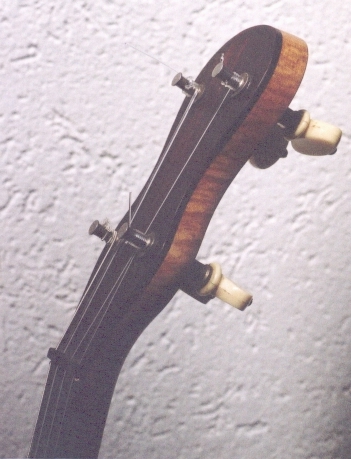
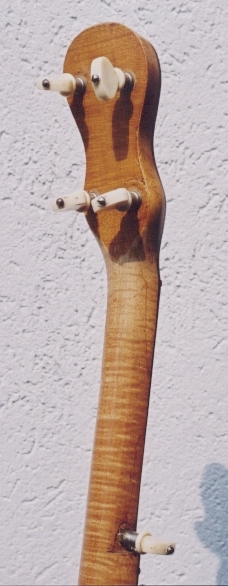
Tailpiece
Here you can see the only real flaw in this instrument: the
bolt that is screwed into the end of the dowel stick is too high up. This is
because the dowel stick was warped upwards, and thus had to be attached higher
up on the rim to get the neck aligned with the pot. You can also see the
reproduction "No-Knot" tailpiece, which I fitted in the course of
conversion to nylon strings.
The original hooks, hex shoes and plain tension ring are
clearly visible, as is the lap of the head round the wire flesh hoop. I fitted
the present head, by the way, somewhere around 1980, when the old one split. It
is a fine, white vellum head.
The bridge is the one that my father obtained in the 1950s
for the first renovation. It is rosewood, and matches the fingerboard very well.
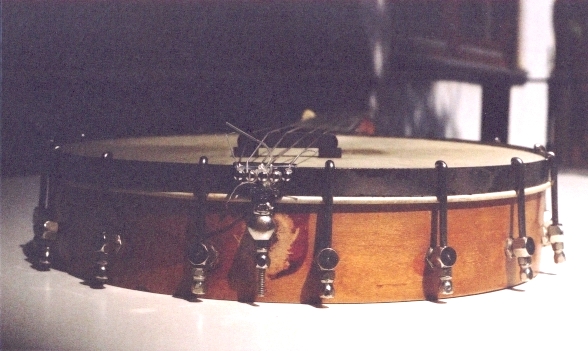
This is the Windsor zither-banjo that I bought in 2004, after I had begun
to learn finger-style banjo. It is the company's "Popular" Model No.
5, which they advertised as their lowest-level professional instrument.
Here is how it was advertised on Ebay: 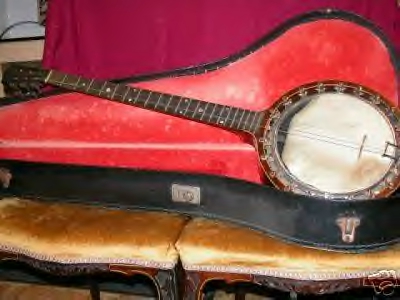
...and here is what it looks like now: 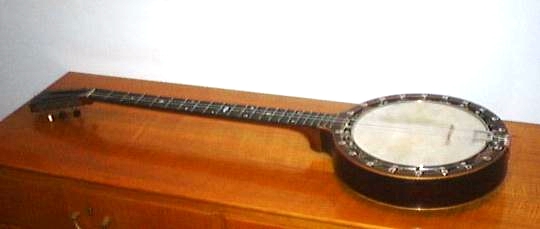
As you can see, there was work to be done!
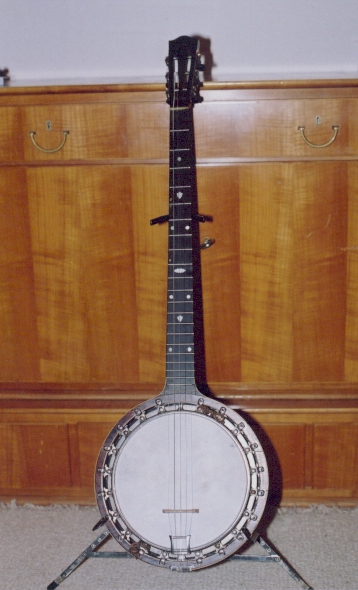 The
most obvious task was to put on a new head. With the small head diameter of the
zither-banjo at 8 3/4" (22 cm), plastic heads are not available, so it had
to be vellum, which is more in keeping with the age of the instrument anyway.
The
most obvious task was to put on a new head. With the small head diameter of the
zither-banjo at 8 3/4" (22 cm), plastic heads are not available, so it had
to be vellum, which is more in keeping with the age of the instrument anyway.
Fitting a skin head to a zither-banjo is no different from the same job on
a conventional banjo, as I discovered.
The bridge was damaged, so I made a copy of it in oak.
The MOP marker at the 10th fret was missing - of all the markers, the most
elaborate one! However, with a bit of advice on mother-of-pearl inlay from the
Internet, a replacement was cut out and inserted, using the existing hole as a
pattern. (Usually, the hole is fitted to the inlay, not vice versa!)
There was one cosmetic flaw left to fix: the pinion of the top right
tuning machine was missing. This is not really a show-stopper on a zither-banjo,
because there are only 5 strings but 6 tuners - and the top right tuner is the
one that is only for decoration, and is not used. However, with no pinion to
mesh with the worm on the knob, the extra tuning roller was loose in its hole,
and likely to rattle. I thought of extracting it (like a bad tooth!) but then I
found an old mandolin tuning roller with a pinion that fitted, and put that in
instead. The worm and pinion mesh, but are rather stiff, which is actually a
good thing - rattling is impossible!
With new strings, the Windsor was ready to go. Again acting on advice from
the owners of the zither-banjo site
in the Internet, I used conventional, light gauge, steel banjo strings for the
1st, 2nd and 5th, and nylon guitar strings for the 3rd and 4th. This looks a bit
odd on paper, but it is the conventional stringing for a zither-banjo, and
actually sounds well balanced when played.
Not very long after starting to play the Windsor in public, I had a
mishap. On opening the case one day, I discovered that the knob of the top left
tuner was missing. Its shaft had been a little bent, and now the Bakelite knob
had split and fallen off. This was a show-stopper, but fortunately I had
an old set of guitar tuning machines with softish plastic knobs, one of which I
filed to the shape of the original and forced onto the shaft. The function was
perfectly restored, but unfortunately the replacement knob is white, the
originals black!
By the way, the zither-banjo can be a bit confusing to the uninitiated.
A first glance at the peg-head (see photo right) suggests that the
instrument is 6-stringed, because there are six pegs. In fact, it is a 5-string
banjo, even though it does not have the 5th peg in the side of the neck like
"normal" 5-strings. It does, however have a "short" 5th
string - this is long enough to reach the peg-head, but runs in a tunnel under
the first 4 frets, so it is playable only from the 5th fret upwards. In short,
close your eyes and just play it, and you wouldn't know it wasn't a
"normal" 5-string banjo!
I bought this soon after founding the group interFolk. The banjo was my
main instrument in the group, and I needed a bit more volume than the old
open-back gave me.
It is a Japanese-made instrument with an aluminium pot and wood resonator
- not exactly a top-of-the-line banjo! However, it is loud, the intonation is
good right up the neck, which is straight; the action is low, and it plays well.
For amplified gigs, I fitted a piezo-electric pickup under the head, which is a
new Weatherking frosted one.
For faster change of key during performances, I devised and fitted a
sliding 5th-sting capo, and for improved appearance and ease of use I replaced
the original guitar-type machine heads with Schaller geared banjo pegs.
 It
has no identifying markings of any kind, so it could
It
has no identifying markings of any kind, so it could have come from anywhere. From an American sailor in need of ready cash,
perhaps? Or by mail order from a shop in the UK? Or brought home by some long
deceased islander from wherever he had been?
have come from anywhere. From an American sailor in need of ready cash,
perhaps? Or by mail order from a shop in the UK? Or brought home by some long
deceased islander from wherever he had been?  wedges. What you cannot see is the tone ring, which is a band of steel standing
a couple of millimetres proud of the wooden rim in a rebate in the outside of
the rim. The ends of the tone ring are not welded or soldered; the ring is held
snugly in place by the tension of the head. The flesh hoop (galvanised wire) is
also open.
wedges. What you cannot see is the tone ring, which is a band of steel standing
a couple of millimetres proud of the wooden rim in a rebate in the outside of
the rim. The ends of the tone ring are not welded or soldered; the ring is held
snugly in place by the tension of the head. The flesh hoop (galvanised wire) is
also open.



 The
most obvious task was to put on a new head. With the small head diameter of the
zither-banjo at 8 3/4" (22 cm), plastic heads are not available, so it had
to be vellum, which is more in keeping with the age of the instrument anyway.
The
most obvious task was to put on a new head. With the small head diameter of the
zither-banjo at 8 3/4" (22 cm), plastic heads are not available, so it had
to be vellum, which is more in keeping with the age of the instrument anyway.